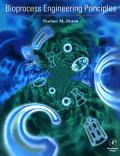
Cover 

BIOPROCESS ENGINEERING PRINCIPLES
Author: By Pauline DoranISBN13: 9780122208560
Publisher: Elsevier
Price: €68.95
Pages: 439
Edition: Paperback
Publish date: April 1995
Outline:
The emergence and refinement of techniques in molecular biology has changed our perceptions of medicine, agriculture, and environmental management. Scientific breakthroughs in gene expression, protein engineering, and cell fusion are being translated by a strengthening biotechnology industry into revolutionary new products and services. Many a student has been enticed by the promise of biotechnology and the excitement of being near the cutting edge of scientific advancement. However, graduates trained in molecular biology and cell manipulation soon realize that these techniques are only part of the picture. Reaping the full benefits of biotechnology requires manufacturing capability involving the large-scale processing of biological material. Increasingly, biotechnologists are being employed by companies to work in cooperation with chemical engineers to achieve pragmatic commercial goals. For many years, aspects of biochemistry and molecular genetics have been included in chemical engineering curricula, yet there has been little attempt until recently to teach aspects of engineering applicable to process design to biotechnologists.This textbook is the first to present the principles of bioprocess engineering in a way that is accessible to biological scientists. Other texts on bioprocess engineering currently available assume that the reader already has engineering training. On the other hand, chemical engineering textbooks do not consider examples from bioprocessing, and are written almost exclusively with the petroleum and chemical industries in mind. This publication explains process analysis from an engineering point of view, but refers exclusively to the treatment of biological systems. Over 170 problems and worked examples encompass a wide range of applications, including recombinant plant and animal cell cultures, immobilized catalysts, as well as traditional fermentation systems.


 Firmen
Firmen Bücher
Bücher